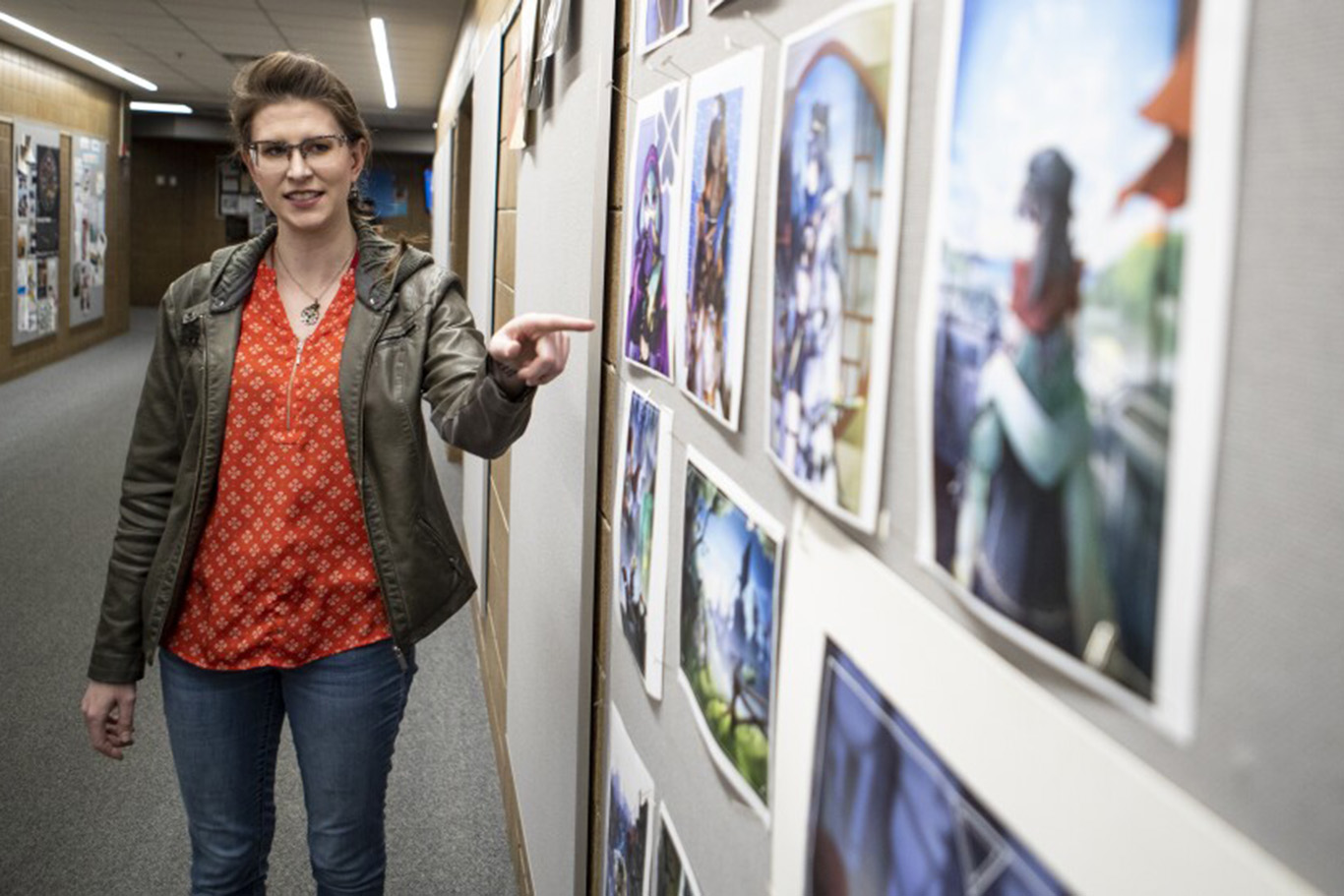Game On
REGARDLESS OF WHERE YOU FALL ON THE CONTINUUM OF THE IMPACT VIDEO GAMES HAVE ON THE WORLD, REST ASSURED THEY ARE HERE TO STAY.
150 million Americans play video games.
60% of Americans play video games daily.
56% of frequent gamers play multiplayer games at least once a week. Who are they playing with?
42% play with friends
19% play with family
17% play with parents
16% play with their spouse
55% of frequent gamers say video games connect them with their friends.
46% say it helps their family spend time together.
(Source: Essential Facts about the Computer and Video Game Industry, Entertainment Software Association)
Those are telling statistics about the value of connecting via video gaming. Talking to each other. Spending time together. Participating in a mutually enjoyable activity. It’s the upside to what some may consider a waste of time.
League of Dragons
Mark Rose’s ’98 (art) introduction to the world of gaming occurred long before the days of Nintendo.
“When I was in the first grade, my brother was playing a baseball game on a friend's Atari 2600. He handed me the controller to try for the first time. I hit a home run and I thought it was the coolest thing in the world to control what I saw on the screen with my hands,” Rose said. “It was a marriage of technology and art.”
The community of gaming inspired Vong Pha ’15 (graphic communications) and his friends to start the MSUM student organization League of Dragons, a competitive gaming group. Not only did they play games, but they also created connections for the future.
“I grew up playing games; it’s something I’ve always loved to do,” Pha said. “What drew me to the gaming industry is the strong communities built behind video games.”
MSUM’s animation degree came online in 2013, long after Rose graduated, and near the end of Pha’s schooling. But MSUM’s art and graphic communications programs are ideal training for future game artists.
At age five, Rose’s kindergarten self-portrait demonstrated creative talent. “It was obvious to my teacher and my parents that my drawing stood out from the others. I always knew I wanted to be an artist.”
At MSUM, he split his time between the art studio and the football field. He fondly remembers Coach Ralph Micheli and his teammates.
“I made a lot of lifelong friends,” Rose said. “I lived in two different worlds—football and art. There weren’t many art students playing football.”
His early career goal was to draw comic books. “However, once at MSUM, it was eye-opening to see how big the art world is,” Rose said. “MSUM introduced me to things I hadn’t considered, and throughout my college years I thought I was going to be an illustrator and painter.”
He enjoyed collegiate success in football and art. His senior year he was a finalist in the Corel World Design Contest. Later that year, he was hired to create a nostalgic Harley-Davidson painting for the Sturgis Motorcycle Rally. The painting was celebrated, hundreds were sold, and he loved doing it. He was ready to take on the world. He moved to Minneapolis after graduating and discovered the competitive field of illustration.
“I hired an illustration agent, which didn't help much at all,” Rose said. “I worked on a lot of small illustration jobs, but once the jobs became scarce, I ended up getting an overnight supervisor job at OfficeMax to make ends meet. My night job became my full-time job, and I was struggling to make it.”
Veteran game developer John Talley reached out to Rose to hire him in a gaming start-up. “I thought it was another illustration job I could put toward the rent, but then it turned out to be an open door to an industry I never thought I would be a part of. It was total jubilation,” Rose said.
Fallout
The thrill was short-lived with the arrival of the dot-com bubble; a roller coaster ride ensued with companies going out of business, start-ups getting bought out and massive layoffs occurring in an erratic industry. Rose segued to designing for the world’s leading live fire and simulation weapons training systems company.
Fast forward two years and Talley reached out to Rose again to be a founding partner of the independent game studio Mock Science.
“Mock Science was the real deal as far as video game development,” Rose said. “We struggled for a few years figuring out our niche, but we worked with publishers on a few projects that did well, such as Tiki Towers and Mahjong Garden Deluxe. Eventually, we were bought out.”
Then another buyout. And another. Then Zynga, one of the biggest names in the social gaming industry, purchased the company. He worked with Zynga until the company laid off nearly 20 percent of its workforce.
“That was a donkey-kick to the face,” Rose said. “The industry is insanely volatile when it comes to turnover. If a person were to ask me about working in video games, I’d ask them if they’re OK living like a nomad. I’ve been relatively lucky in that respect; a lot of friends and colleagues, not so much.”
Battlefield
Pha’s experience with the gaming industry is similar. He’s done a lot of freelance work with startups and individuals, including visual development and 3D animations with Tiger Byte Studios. He recently completed his master’s degree in interactive technology at SMU Guildhall, one of the top schools for game design in the world. While there he completed three game projects.
“We partnered with artists, software developers, designers, producers and stakeholders to simulate game development environments,” Pha said. “The best lesson I learned at SMU Guildhall is how to think on your feet and adapt quickly, because planning and communication felt like 75 percent of game development.”
Video game design and video game art are distinctly different, and what each does frequently depends on the size of the company, the scope of the project and how deep the pockets are. Game designers typically create the game’s story, characters and gameplay, working in a team environment with the artists and programmers to create a flow for the game. Game artists may create concept, layout, props, character, vehicle, environment, special effects, lighting, texture or hard surfaces.
As with any creative field, it often starts with simple sketches.
“I usually start with napkin sketches at a restaurant or coffee shop,” Pha said. “From there, I refine those thumbnails in a 2D software like Adobe Photoshop to get a better idea of the shapes and materials the final 3D models will look like. Afterward, it goes into a 3D software package where I either sculpt digital clay or play around with a digital box until I achieve the expected results, then I put it into a game engine. The key is to get something into the game engine as soon as you can because this crucial part will determine your next steps.”
Pha says game artists must be flexible in their process and skills, especially when working with small companies where an artist can expect to touch multiple aspects of the game’s artwork.
Because most of Rose’s work has been with start-ups or small companies, he describes himself as a generalist who has worn many different hats.
“I credit MSUM’s art department for giving me a strong foundation in traditional art. Anyone can learn how to use a program, but to have that foundation is key to standing out in an ocean of talent,” Rose said. “I was constantly challenged by instructors like Allen Sheets and Carl Oltvedt to come up with ideas, concepts and final images often in a relatively short amount of time. This prepared me for a lifetime of art creation in many industries.”
Creating art for a video game can last anywhere from a few months to several years, depending on the talent, team size and project.
Creating a memorable and appealing game experience requires paramount gameplay and realistic interactive immersion into the game world. A strong storyline creates attachment to the characters and instills a desire to continue playing to see how the story unfolds. Beautiful art touches everything the player sees, from the environment to the characters to the texture.
“It’s like a ballet,” Rose said. “If things aren’t working well together, it can kill the experience. And if you don’t have a good experience, it’s not a great game.”
When all elements converge successfully, and the player is challenged, energized and engaged, chances are that game will see the light of day.
Most, however, don’t.
Such as two contracts Pha worked with in Fargo-Moorhead, both now defunct.
“Studios have a high turnover rate, so it’s important to look for other opportunities,” Pha said. He currently contracts with Tiger Byte Studios, a mobile game development studio. “This team has four developers working together, but that’s all I can say. That’s one of the things about the game development industry; you almost feel like you’re a secret agent. You know you’re working on something special, but you can’t tell people what it is you are working on.”
He’s also worked on projects in the UK and India, with time zone differences posing the biggest challenge. However, he enjoys learning about other peoples’ workflows and culture. “One of the exciting parts of being a freelance artist is working with people across the globe,” Pha said.
Rose is a contract artist working on video slot games for Aurify, a casino game development company. To get back to his gaming roots, and his passion, he and a friend started Game Gobblers, LCC.
Last winter, they soft-launched the Android version of The Holiday Junction: Jingle Edition. It’s now available on App Store, Google Play and Amazon Appstore.
“It’s a gallery game to retrieve toys, turn them into presents, and get them back to Santa before Christmas,” Rose said. “It’s fun to experience and play with the evolution, as we are constantly pushing it further to see what more we can do.
“We’re just two guys creating a totally indie game that will hopefully find an audience. We’re a very small drop in the ocean of apps and games on Android and iOS,” Rose said. “This is the first stone in what we hope will be a larger foundation moving forward. For every indie developer success story, there are thousands of failures. Publishing on two platforms is a huge hurdle in itself. Last year we were No. 31 on Google Play’s Top New Paid Family apps list. We must be doing something right.”
Pha knows video game development is a crapshoot. That being said, he’s passionate about gaming and is growing his skill set to advance in the field.
“MSUM opened my eyes to how volatile the industry can be. It taught me to keep on my toes so I can easily pivot when needed,” Pha said. Keeping current with the latest trends and technology is a big challenge. “In the past two years, the game industry has shifted heavily from taking a lot of the manual work out of creating artwork to automated and procedural tasks.”
Pha’s goal is to grow in the gaming industry because, “I love it too much to stop doing it. I would like to open my own studio and eventually mentor and teach. Another great thing about being a game artist is your art skills transfer easily across multiple fields.”
Call of Duty
Both Rose and Pha keep their pulse on the industry by being avid consumers of video games.
Every Wednesday night, Rose, along with family and friends scattered across the country, connect via multiplayer video games.
“It’s our social time to talk, joke around and hang out,” Rose said. “Even though we’re all busy, we’re there for each other virtually.”
Pha, too, connects with friends across the country by playing video games a couple of hours each day, in the interest of research, of course. “It’s amazing to see how video games bring people together on a global scale.”
This story was first published in Moorhead Magazine, Spring 2019.
MAKE SURE YOUR STORY IS HEARD
Let us know how your life has been changed by being a Dragon: tell us your MSU Moorhead story today!
Send Us Your Story


